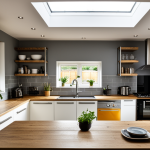Essential steps for child-proofing your UK home
Creating a safe home environment for children in the UK requires addressing both practical and regulatory aspects. Understanding UK safety regulations is crucial—they set minimum standards for products and installations to reduce hazards. This includes ensuring that stair gates comply with British safety standards, electrical outlets are secured, and window locks meet specific guidelines to prevent accidents.
A step-by-step child-proofing checklist begins with identifying risks in each room. For example, in the kitchen, securing cupboards with safety locks and using corner protectors on counters can prevent injuries. Living rooms often benefit from anchoring furniture to walls and covering sharp edges. Bedroom safety includes choosing cordless blinds and using breathable bedding made to approved safety specifications.
In the same genre : How Can You Transform Small Spaces into Cozy Havens?
When selecting products, opt for recommended UK child-proofing items like approved safety gates, non-toxic paint, and corner guards designed to meet British standards. These products not only comply with safety regulations but are often tested for durability and performance.
With careful planning based on UK regulations and practical home safety advice, you can significantly reduce risks and create a secure space where children can thrive.
Also read : How Can You Transform Small Spaces in Your UK Home into Functional Areas?
Essential steps for child-proofing your UK home
Creating a completely child-proofed home involves understanding UK safety regulations and implementing practical solutions room by room. These standards govern everything from stair gates to electrical outlet covers, ensuring products meet strict safety criteria to reduce accidents.
To begin, conduct a detailed child-proofing risk assessment, identifying hazards in common areas such as the kitchen, living room, and bedrooms. For example, securing cupboard locks and installing corner protectors in kitchens prevents injuries, while anchoring furniture and guarding sharp edges protects in living spaces. Bedrooms benefit from cordless blinds and bedding compliant with fire safety regulations.
A thorough child-proofing checklist embraces a blend of approved UK safety-standard products and smart placement strategies. Recommended items include safety gates tested for durability, socket covers that prevent electrical shocks, and non-slip rugs to avoid falls.
Adhering strictly to UK safety regulations paired with this step-by-step method not only heightens home safety for children but also offers peace of mind. Prioritising these safe home tips creates an environment where children can explore freely without exposure to unnecessary risks.
Essential steps for child-proofing your UK home
Understanding and adhering to UK safety regulations is fundamental when child-proofing your home. These regulations set the baseline for product design and installation to ensure maximum protection. For example, safety gates must comply with strict British standards to prevent falls, while electrical outlets require covers meeting specific safety tests to avoid shocks.
A clear step-by-step child-proofing checklist starts with room-by-room hazard identification. In kitchens, secure cupboards with robust locks and install corner protectors to guard sharp edges. Living rooms require anchoring furniture and protecting corners to prevent tip-overs and bumps. Bedrooms benefit from cordless blinds to eliminate strangulation risks and bedding that adheres to fire safety standards.
Choosing recommended child-proofing products made to UK standards enhances safety and durability. Look for tested safety gates, socket covers designed to resist tampering, and non-toxic paints. Complying with UK safety regulations not only minimizes accident risks but also provides reassurance that your home meets trusted safety benchmarks, establishing a truly safe home for children.
Essential steps for child-proofing your UK home
Adhering to UK safety regulations is the cornerstone of effective child-proofing. These standards dictate that products such as safety gates, socket covers, and furniture anchors must pass rigorous testing to ensure they protect children from common household hazards. Compliance with these regulations guarantees that home safety for children is not left to chance but built on proven benchmarks.
A step-by-step child-proofing checklist begins by assessing risks room by room. In kitchens, focus on securing cupboards with locks that adhere to UK safety standards. Living rooms require anchoring furniture and placing corner protectors to prevent accidents. Bedrooms should include cordless blinds to eliminate strangulation hazards and fire-retardant bedding certified to UK regulations.
Investing in recommended child-proofing products designed specifically for the UK market enhances safety and durability. These include tested safety gates with secure latches, electrical socket covers that resist tampering, and non-toxic paints verified to meet safety criteria. Incorporating these safe home tips systematically ensures your living environment consistently prioritises child well-being in line with UK legal requirements.
Essential steps for child-proofing your UK home
Child-proofing a home effectively starts with strict adherence to UK safety regulations. These regulations are designed to ensure that all child-proofing measures meet robust standards—covering everything from safety gate strength to electrical socket covers that prevent tampering by young children. Compliance guarantees your home meets minimum legal safety thresholds, reducing potential hazards.
A comprehensive step-by-step child-proofing checklist should follow a room-by-room approach. In kitchens, this includes installing secure cupboard locks that meet UK standards and covering sharp edges with protectors. Living rooms require anchoring furniture securely to prevent tipping and using corner guards on sharp surfaces. Bedrooms must feature cordless blinds to eliminate strangulation risks and bedding materials that comply with fire safety laws.
Choosing the right recommended child-proofing products is crucial. Opt for safety gates tested to British standards, durable socket covers, and non-toxic paints approved for child safety. Implementing these safe home tips systematically not only safeguards children but also provides parents with confidence, knowing their home environment is well-protected and fully compliant with UK safety standards.
Essential steps for child-proofing your UK home
Complying with UK safety regulations is fundamental to effective child-proofing. These legal standards ensure that products like safety gates, socket covers, and window locks meet rigorous safety tests designed to prevent common household accidents. Using items certified to these regulations guarantees a baseline of quality and protection for your home safety for children.
A detailed, step-by-step child-proofing checklist should begin with evaluating each room’s unique risks. Kitchens need secured cupboard locks aligned with UK safety standards and corner protectors to reduce injury likelihood. Living rooms require anchoring furniture and safeguarding sharp edges to prevent tip-overs and bumps. In bedrooms, eliminate hazards by installing cordless blinds that comply with safety guidelines and selecting fire-retardant bedding verified for UK homes.
Investing in trusted, recommended child-proofing products enhances safety. Choose safety gates tested for durability, tamper-resistant electrical socket covers, and non-toxic paints that conform to UK safety norms. Applying these safe home tips consistently fosters a secure environment, helping parents confidently provide homes where children can explore safely and thrive.
Essential steps for child-proofing your UK home
Child-proofing your home in line with UK safety regulations means prioritising both compliance and practicality to ensure effective protection. These regulations require that safety equipment, such as security gates and socket covers, pass rigorous tests to prevent common hazards. For instance, safety gates must have secure latches and be fitted properly to withstand pressure, avoiding falls.
A comprehensive step-by-step child-proofing checklist involves systematically assessing each room’s hazards. In kitchens, install locks on cupboards and drawers that meet British standards and add corner protectors to counters. The living room should include furniture anchors and corner guards designed to prevent tip-overs and sharp-edge injuries. Bedrooms demand particular attention to window locks, cordless blinds, and fire-retardant bedding compliant with safety rules.
Selecting recommended child-proofing products made specifically for the UK market ensures durability and compliance. These include tamper-resistant socket covers, safety gates tested for strength, and non-toxic paints suitable for children’s environments. Applying these safe home tips consistently develops a secure environment, reducing injury risks while adhering to legal safety benchmarks.







